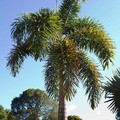Palms, Palms, Palms here are a few things you may not get told at a nursery. There are over 25000 species of palms that grow in tropical, subtropical, and warm temperate climates around the world. Over 50 of these are found to grow in Australia. They are extensively throughout Australia including Sydney, Melbourne and Brisbane widely used in landscaping due to their exotic appearance and can make any garden atmosphere cool and relaxing, much like a tropical paradise.
Although purchasing a smaller palm tree will be less expensive, like most other plants, palms take a while to grow, and will take longer for it to grow to its potential and won't have that "instant gratification" of a large beautiful plant. If you cannot wait for your tropical paradise to arise, there are fast growing varieties; Bangalow Palm, Cocos Palm or Queen Palm, Foxtail Palm and Majestic Palm.
When purchasing a palm it is important to choose a variety that suits the conditions of your local area. Consider temperature, rainfall, soil, sunlight and also the space available for growth. Also consider how much time you have to care and clean up your palms? Palms like the Cabbage Palm require very little maintenance, others like the Chinese Fan Palm tree are fussier. As well most palms love fertilizers in order to grow optimally. See our "Palm Growth Chart" as a quick and easy guide
Some palms prefer to be under the shade while others welcome the heat. Palms like the Alexandra and the Foxtail like full sun from early age but do well in either condition. Cascades (Chamaedorea cataractarum), Lady Palms (Rhapis excelsa), Ponytail Palm and Australia Fans (Licularis ramsayi) like some shade while the Kentia palm (Howea forsteriana) takes time to adjust but all these make good indoor palm trees. Indoor palms benefit from being taken outside every few weeks to receive full sun in order to regain strength.
The watering needs of your palms is also important to understand, there are tropical palms that naturally grow near rivers, lakes and estuaries requiring them to receive plenty of water when cultivated the Cascade palm (Chamaedorea cataractarum) is an example of this. Irrigation is heavily needed by this variety in order to grow fully. There are also palms that are more low maintenance when it comes to water requirements like the Ponytail Palm. It is highly resistant to droughts and can last up to a month without water. To maintain it though, it would be advisable to mist the leaves to keep from drying, especially if it's humid.
Soil is another important factor in helping your palm grow to its best capabilities. Soils can be too salty, wet, alkaline, sandy or heavy with clay. Most palm species prefer a pH of between 6.4 and 7. Lower than 6.0 pH nitrogen, phosphorous and potassium are lost to the palm. Higher than 7.0 pH iron, manganese, boron, copper and zinc are locked out and lost. If your soil is too acid adding dolomite or lime will make it more alkaline. Ideal soil to use is a 50/50 blend of your native soil and bought soil or potting mix made from aged manures, compost and mulch. Salty soils need to be drained.
At Palms Online we sell palm trees from our Nursery located near Byron Bay, supplying Nurseries up and down the east coast for the last 15 years, we pride our selves on selling well established sun hardened palm trees whilst trying to provide the best information to ensure your palms grow fast and remain healthy.
Palms online.
<< Previous Palm trees that will grow in Sydney, Wollongong, Newcastle, South and Central Coast | Back to Mullumbimby Palm Blog | Next >> PALMS AROUND SWIMMING POOLS



